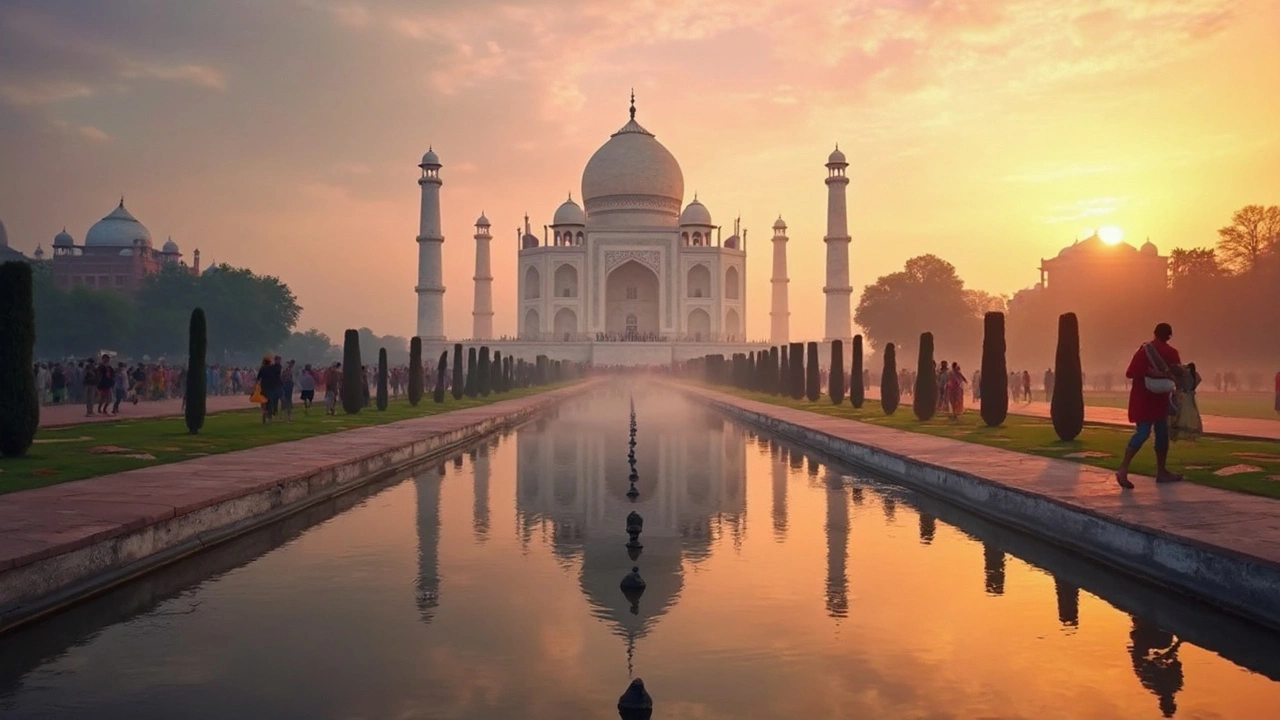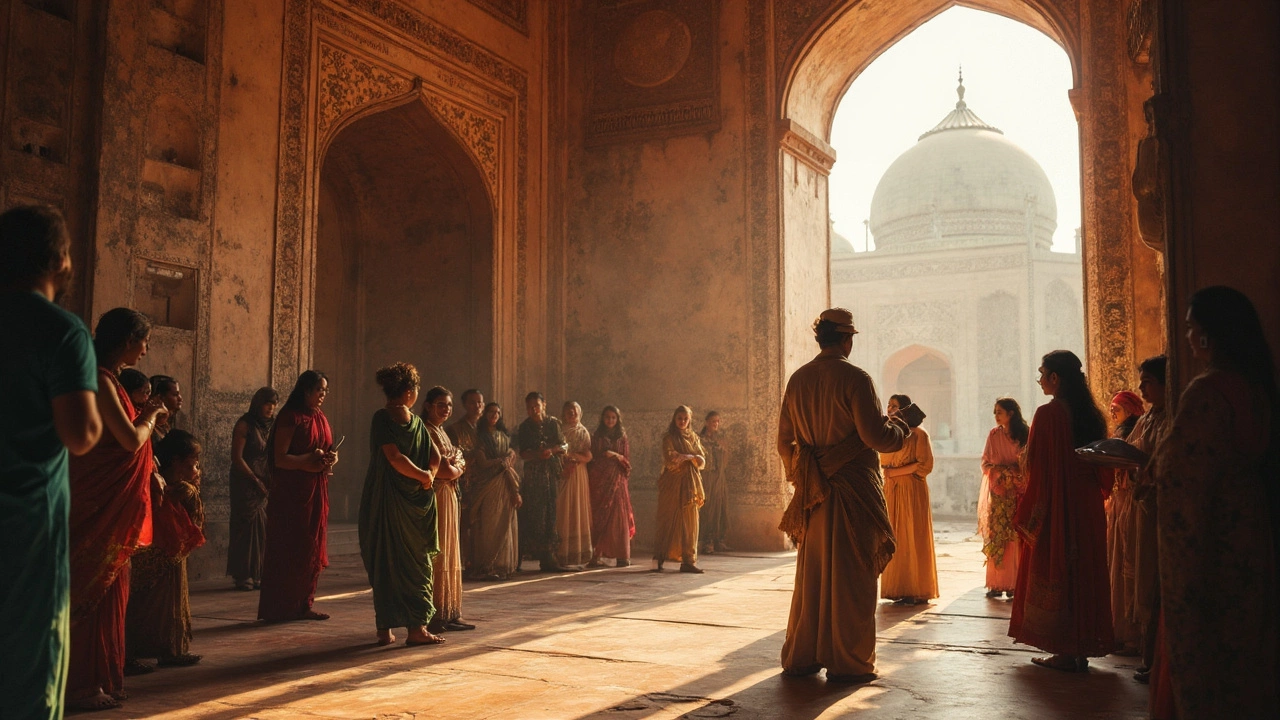Taj Mahal: The Number One Tourist Attraction in India for Cultural Travelers

- Apr, 20 2025
- 0 Comments
- Aaron Blackwood
If you ask travelers about India’s biggest must-see, the Taj Mahal usually comes up first every single time. There’s good reason for that—it’s not just insanely beautiful, but it’s also a piece of history you can walk right into.
The Taj Mahal isn’t just a famous photo op. It’s a real reminder of how one person’s love can create something the whole world admires. More than seven million tourists visit each year, and while the white marble domes look dreamy in every Instagram shot, actually being there is something else—especially when the morning sun hits the stones and the whole place glows.
It doesn’t matter if you’re big on history, architecture, or just want to tick off some major bucket list items. The Taj Mahal packs all those things into one spot. But here's the thing: if you don't plan properly, you could end up fighting crowds or missing the good light for photos. You’ll want some solid tips before you go.
- Why the Taj Mahal Tops Every Must-See List
- A Quick Guide to Visiting the Taj Mahal
- Hidden Stories Behind the Marble
- Practical Tips for an Unforgettable Visit
Why the Taj Mahal Tops Every Must-See List
The Taj Mahal isn’t just the face of India tourism; it’s basically a calling card for the entire country. People line up from all corners of the world to see it in person because it's truly one of those places that lives up to the hype. Built in the 1600s by Emperor Shah Jahan as a tribute to his wife Mumtaz Mahal, the story behind it is as grand as the building itself. We're talking about 20,000 workers and over 1,000 elephants pitching in to get the job done. That’s serious dedication.
A lot of folks think the Taj Mahal is just a mausoleum, but it’s really a whole complex. There are stunning gardens, a mosque, and those famous reflecting pools that make every sunrise and sunset look epic. The mix of Persian, Islamic, and Indian architecture draws in buffs from everywhere—engineers, artists, the merely curious—you name it.
Recognized as a UNESCO World Heritage Site since 1983, this spot pulls in more than seven million visitors a year. It’s rare for any one attraction to have this kind of pull for so many generations. Check out some quick facts that show the Taj’s impact:
| Fun Fact | Details |
|---|---|
| Year Built | 1632 - 1653 |
| Annual Visitors | 7 million + |
| UNESCO Status | Since 1983 |
| Cost to Build | ~32 million rupees (in 17th-century money) |
The Taj Mahal’s marble changes color with the sun—from soft pink at dawn to blazing white at noon and golden at dusk. It's not just a monument but an experience that feels different depending on when you go and who you're with. If you care about snapping that perfect shot, timing your visit for sunrise is usually a winner—fewer crowds and incredible lighting.
This spot isn’t just for architecture nerds or romance seekers either. Its story, details, and scale make it a crowd-pleaser for nearly every kind of traveler. The recognition and foot traffic don’t lie—it really is the number one Agra attraction and likely the top sight in all of India.
A Quick Guide to Visiting the Taj Mahal
The Taj Mahal is in Agra, about 200 kilometers (125 miles) from Delhi. Most people get there by train—it's fast and way less hassle than driving. If you’re traveling from Delhi, the Gatimaan Express will get you to Agra in just 100 minutes. Auto-rickshaws and cycle rickshaws are the best way to cover the last mile from the station to the entrance.
The Taj Mahal opens at sunrise and closes at sunset every day except Friday. Fridays are off-limits for tourists because the mosque inside is used for prayers. If you want fewer crowds and that perfect soft light for photos, go super early—think 6 a.m.—especially in the cooler months from November to February.
- Foreigners pay INR 1300 (about $15) for entry. Indian citizens pay INR 50. If you want to go inside the main mausoleum, there’s an extra fee.
- You can’t bring big bags, food, or tripods inside. Security checks are strict and the lines can get long, especially on weekends and holidays.
- Shoes must come off or get covered when you’re walking on the marble platform. The guards hand out shoe covers with your ticket.
If you want to avoid big crowds, skip weekends and aim for weekdays. And don’t even think about visiting during the Indian summer (April to June)—the heat is brutal. The best time is from October to March when the sky is clear and you won’t melt after ten minutes outside.
| Opening Days | Hours | Best Time to Visit |
|---|---|---|
| Saturday–Thursday | Sunrise to Sunset | October–March, before 8 a.m. |
| Friday | Closed for prayers | — |
If you’re into night photography, during full moon nights, there are special night viewing sessions—tickets are limited and must be bought in advance. You won’t get this kind of view any other way.
Carry water, keep your camera ready, and plan for at least two hours inside the complex. The Taj Mahal is the ultimate Agra attraction, so take your time soaking it all in.

Hidden Stories Behind the Marble
The Taj Mahal looks like a simple symbol of love, but if you start digging, you find tons of hidden facts and stories most people miss. First off, it was built by Emperor Shah Jahan in memory of his third wife, Mumtaz Mahal. She died in 1631 during childbirth, and he started building the mausoleum that very same year. Construction finished in 1653, so imagine 22 years of hard work—and we’re talking about over 20,000 workers coming from all over India and Central Asia.
What a lot of travelers don’t realize is how much detail went into making the Taj Mahal. The white marble came from Rajasthan, while the turquoise and lapis lazuli used in the inlay work were shipped from as far as Tibet and Sri Lanka. Everything you see—the flowers, the scripts, the patterns—was placed with crazy precision. Flip through the carvings and you'll spot verses from the Quran, carved in perfect symmetry everywhere you look.
Here’s a cool stat that surprises most visitors:
| Material | Where It Came From | Distance (Approx.) |
|---|---|---|
| White marble | Makrana, Rajasthan | 400 km |
| Jade, Crystal | China | 4,000 km |
| Lapis Lazuli | Afghanistan | 1,700 km |
| Turquoise | Tibet | 2,500 km |
Another wild story—there’s a rumor Shah Jahan planned to build a “Black Taj Mahal” for himself on the other side of the river. Historians mostly agree it’s just a legend, but if you stand on the riverbank, you kind of see why the myth stuck around.
Here’s something practical: the four minarets are actually tilted outward slightly, on purpose. This wasn’t a mistake—the builders did it so they’d fall away from the main tomb if there was an earthquake. Smart move, right?
The last twist? Shah Jahan never got to see his dream project finished the way he planned. His son, Aurangzeb, kept him under house arrest near Agra Fort. From his window, he could only see the Taj Mahal from afar, and when he died, they buried him next to Mumtaz inside the mausoleum—a low-key ending to such a massive love story.
Practical Tips for an Unforgettable Visit
Making your Taj Mahal trip smooth and memorable boils down to a few simple moves. You want to beat the crowds, lock in the best photos, and avoid avoidable hassles—here’s how to do it right:
- Visit Early Morning or Late Afternoon: The gates open at sunrise, and that’s the sweet spot to see the Taj Mahal without elbowing through massive tour groups. Plus, the marble looks incredible when the sun’s just coming up. If mornings aren’t your thing, try just before sunset—same vibe, fewer people compared to midday.
- Buy Tickets Online: Skip the long ticket lines and grab your official tickets on the ASI (Archaeological Survey of India) website. Foreign tourists pay about 1300 INR (roughly $16), while Indian residents pay 50 INR. If you want inside the main mausoleum, there’s a little extra fee.
- Pack Light: Large bags aren’t allowed inside. Security checks can be strict, so stick to basics—phone, wallet, camera, reusable water bottle. Leave snacks, books, or drones at the hotel.
- Choose Your Entry Gate: There are three main gates—East, West, and South. The East and West gates usually open earliest; the South gate is least used but only for exit. Pick what works for your hotel location.
- Shoes Off Near the Main Building: You have to remove your shoes (or use the shoe covers they hand out) to enter the main mausoleum. It’s a hygiene rule, but brings its own charm.
- No Food or Tobacco: You can’t bring food, chewing gum, or tobacco into the complex. Authorities mean business about this, so finish up outside.
- Fridays Are Off-Limits: The Taj Mahal is closed every Friday for prayers. Double-check your dates before you plan.
For anyone fixated on the perfect photo, the north-west side offers excellent views with the classic reflecting pool. Want the classic ‘centered’ shot? Get in line near the platform, or try sneaking to the sides for a quicker picture.
| Best Visiting Hours | Gate Opening Time | Crowd Level |
|---|---|---|
| 6:00 AM - 8:00 AM | Sunrise | Low |
| 4:00 PM - 6:00 PM | Sunset | Medium |
| 10:00 AM - 3:00 PM | Peak Daytime | Very High |
Don’t forget, Agra can get scorching in summer and chilly in winter mornings, so dress for the weather. Most importantly, try to walk away from the phone for a bit and take in the scale of the place. Moments like that stick with you long after you leave.